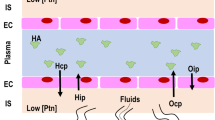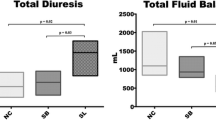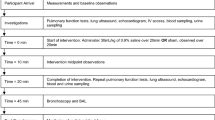Abstract
Hypertonic saline solution (HSS) increases cardiac output (QT) in animals as well as in patients with hypovolemic shock. It has been observed on several occasions that elevations of QT resulted in a concomitant increase of venous admixture (QVA/QT) and/or intrapulmonary shunt (QS/QT).1,2,3 However, Constable et al.4 showed in endotoxemic calves that HSS had no effect on QVA/QT despite an increase of QT. It was the purpose of this study to examine the effect of HSS on QVA/QT in humans with hyperdynamic septic shock.
Access this chapter
Tax calculation will be finalised at checkout
Purchases are for personal use only
Preview
Unable to display preview. Download preview PDF.
Similar content being viewed by others
References
P.H. Breen, P.T. Schumacker, G. Hedenstierna, J. Ali, P.D. Wagner, L.D.H. Wood. How does increased cardiac output increase shunt in pulmonary edema? J Appl Physiol 53:1273–1280 (1982)
J.D. Michenfelder, W.S. Fowler, R.A. Theye. CO2 levels and pulmonary shunting in anesthetized man. J Appl Physiol 21:1471–1476 (1966)
P.D. Wagner, W. Schaffartzik, R. Prediletto, D.R. Knight. Relationship among cardiac output, shunt, and inspired O2 concentration. J Appl Physiol 71:2191–2197 (1991)
P.D. Constable, L.M. Schmall, W.W. Muir, G.F. Hoffsis. Respiratory, renal, hematologic, and serum biochemical effects of hypertonic saline solution in endotoxemic calves. Am J Vet Res 52:990–998 (1991)
R.C. Bone, C.J. Fisher, T.P. Clemmer, G.J. Slotman, C.A. Metz, R.A. Balk, J.N. Sheagren. A controlled clinical trial of high dose methylprednisolone in the treatment of severe sepsis and septic shock. N Engl J Med 317:653–58 (1987)
M. Rocha E. Silva, E.A. Negraes, A.M. Soares, V. Pontieri, L. Loppnow. Hypertonic resuscitation from severe hemorrhagic shock; pattern of regional circulation. Cire Shock 19:165–175 (1986)
Author information
Authors and Affiliations
Editor information
Editors and Affiliations
Rights and permissions
Copyright information
© 1994 Springer Science+Business Media New York
About this chapter
Cite this chapter
Hannemann, L., Schaffartzik, W., Meier-Hellmann, A., Reinhart, K. (1994). Effects of Hypertonic Saline on the Pulmonary Gas Exchange. In: Vaupel, P., Zander, R., Bruley, D.F. (eds) Oxygen Transport to Tissue XV. Advances in Experimental Medicine and Biology, vol 345. Springer, Boston, MA. https://doi.org/10.1007/978-1-4615-2468-7_13
Download citation
DOI: https://doi.org/10.1007/978-1-4615-2468-7_13
Publisher Name: Springer, Boston, MA
Print ISBN: 978-1-4613-6051-3
Online ISBN: 978-1-4615-2468-7
eBook Packages: Springer Book Archive




